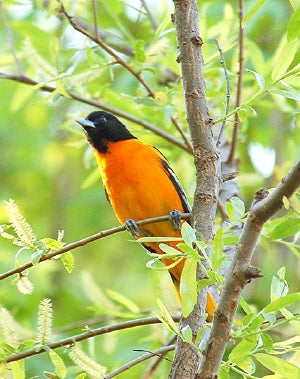
La página que intenta visitar sólo está disponible en inglés. ¡Disculpa!
The page you are about to visit is currently only available in English. Sorry!

The big old apple tree that leans precariously near our front door is full of pink-tinged blossoms. Come August, the lawn will be littered with little green apples (remember that Sixties hit song by Roger Miller?) to the delight of white-tailed deer that wade across the creek from our woods. We'll wake up one morning and a doe or two and their fawns will be gobbling up the worm-pocked spheres.
I had planned to plant pansies yesterday, May 9th, but another front had brought cold, wet weather. So Lois and I settled in the room off our deck to read, a mystery for me, a cook book for her. A serial killer was about to strike another victim when a flash of orange on a flower-heavy branch of the apple tree caught my eye. "The oriole is back," I shouted. I admit to having been little anxious, for I expect to hear the rich whistled notes of this brilliantly garbed songbird by May 5th at the latest.
 |
A lifelong passion for birds often begins with a special species, what Roger Tory Peterson called "the spark." He liked to tell a story about John Burroughs, the great 19th century ornithologist. One spring day in the late 1840s, when Burroughs was a boy, he spied a tiny bird neatly patterned in blue, black and white. A black-throated blue warbler, as he would later learn. "How the thought of it clung to me afterward!" Burroughs remembered. "It was the first intimation I had had that the woods we knew so well held birds that we knew not at all."
My spark happened more than sixty years ago. A pair of Baltimore orioles nested each spring high in the tall elm shading our yard in Michigan. On Saturday mornings when my schoolmates were choosing sides for sandlot baseball, I would lie on my back and watch the male's spirited defense of his kingdom with flashing colors and melodious song. Meanwhile, his mate--hanging upside down from a slender branch--stitched horsehair, strips of bark, sundry plant fibers and bits of yarn and string into a soft but incredibly strong bag, eight inches deep, that would soon hold a quintet of nestlings. My passion for birds has never waned.
We've had nesting Baltimore orioles at Seasons every spring since we found our country retreat in the Hudson Valley 30 years ago. Elms, now all but obliterated by an exotic disease, had once been the species' preferred home site. Our orioles often choose the big sugar maple down by the lane, now also succumbing to blight. There was a small tragedy the second spring of our residence. Tumbling black clouds and a powerful windstorm swept over the hill, and when I went down to pick up branches I found their nest on the ground. Five nestlings that were almost ready to fledge had perished.
According to the Breeding Bird Survey, the Baltimore oriole population in the Northeast has been declining at an annual rate of more than one percent since 1966, which is cause for concern. In 1992, researching an article for National Geographic about declining numbers of Neotropical migrant songbirds, I traveled to Costa Rica to see firsthand what was happening on rain forest wintering areas that were falling to banana plantations, logging, ranching and squatters. It was the week before Christmas and my last stop was La Selva Biological Station, a preserve along the roaring Rio Sarapiquí. Alone, I was near the end of La Selva's trail, elated to have seen the elusive rufous motmot with its long racket-tipped tail, when there was a familiar flash of orange in the rain forest canopy. And I focused my binoculars on an old friend from boyhood, a male Baltimore oriole.
I cannot imagine a summer without orioles.